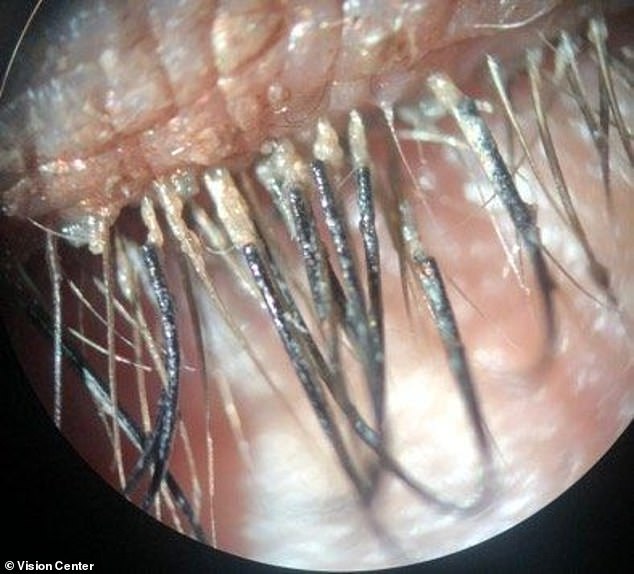Top ophthalmologist reveals the surprising reason why you shouldn’t wear fake eyelashes
Haley Dean, a Nashville hairstylist and mother, said for years that getting eyelash extensions made her feel “so beautiful.”
That was until her eyes became inflamed, red and itchy and her entire face began to swell.
In a panic, she rushed to the emergency room only to find out she was allergic to her fake eyelashes and had to have them removed immediately or risk her eyes swelling shut, she explained on TikTok.
And she’s far from alone, according to Dr. Will Flanary, an Oregon ophthalmologist. Writing on X, Dr Flanary said these popular beauty treatments “look horrible” when patients come in complaining of eye pain and discomfort.
He added that fake eyelashes “often result in red, itchy, swollen and irritated eyelids. The ophthalmologist called them “a sebaceous swamp,” referring to the dirt and oil that builds up under the false eyelashes, which becomes the perfect breeding ground for infections.
Eyelash extensions can lead to infections, allergies and shedding of your natural lashes, experts say. Improper care can also lead to an infestation with small parasitic insects.
In addition to the long eyelashes collecting and harboring germs and bacteria, the glue used to adhere them to the eyelid often contains irritating chemicals and can cause your natural eyelashes to fall out.
It can also cause populations of mites living on your skin to grow rapidly, Dr. Ashley Brissette, assistant professor at Weill Cornell Medicine and founder of Daily Practice, told Daily Mail.com.
If your eyelashes are clean, these mites are relatively scarce. But they like to feed on bacteria, and feeding them more can cause their numbers to explode, wreaking havoc on your eyelashes and leaving waxy deposits on hair follicles.
And complications can arise no matter how clean and professional the application is, as the lashes often create an unsanitary buildup around the eye that is a ‘breeding ground for bacteria’, leading to mite infestations. Doctor Carly Rosean optometrist from Ohio, said on TikTok.
Despite these warnings, the eyelash extension market is booming. Its value was estimated at $1.4 billion in 2020 and is expected to rise to $2.3 billion by 2028. Verified market research.
Eyelash extensions are small, hair-like fibers that estheticians place under, between, or on top of your natural lash line with adhesive to create long, luscious lashes.
The eyelashes can be synthetic, silk or mink and are applied purely for cosmetic purposes. Application and touch-ups can cost between $75 and $300.

Dr. Will Flanary, a trained ophthalmologist, also makes comedy videos online under the character name Dr. Glaucomflecken.
They ideally last between six and eight weeks and can fall out naturally or be removed with a cleaning agent that breaks down the adhesive.
The technique, adhesive type and extension length vary depending on the esthetician you visit, but the extensions can be used to create a natural look or a more avant-garde style.
Many technicians use an adhesive that contains formaldehyde, Dr. Rose said, which can be toxic, especially if you are exposed to it frequently.
Seventy-five percent of professional eyelash adhesives have been tested by Researchers from the University of Minnesota in 2022 contained formaldehyde, despite the fact that none of them stated this on the label.
Formaldehyde is added to products to extend their shelf life or to make them stick better, but it is most often used to preserve dead bodies.
In high concentrations, it disrupts cellular function and can cause shortness of breath, headaches and skin irritation. According to the CDC.
Even if the glue does not contain formaldehyde, users can develop an allergy to any glue or to the eyelash itself. This can cause irritation and swelling and, in extreme cases, damage vision.
Moreover, Dr. Brissette this website that the weight of the extensions can stretch and irritate your natural lashes, causing them to break or fall out. Over time, patients can restore their eyelashes to health, but it can take months and is an intensive process.
It involves avoiding eye products and cleaning the area regularly. If you have a more serious problem, such as a mite infestation, you may also need prescription medication to get your skin health back on track.

The Arkansas patient (pictured) from the case study who developed a Demodex infestation because she didn’t properly clean her eyelashes.
Additionally, placing these foreign objects on the lash line interferes with crucial oil glands that lubricate the eyes and skin, which can leave you with dry, irritated eyes.
This is part of the reason that it is almost impossible to thoroughly clean the extensions, as the oil that naturally moves through the area can build up at the base of the lashes, along with dirt and dead skin.
This buildup provides an ideal environment for bacteria to grow, Dr. Rose said. If your eyes weren’t already irritated, some of these bacteria release chemicals that inflame and irritate the eyes.
This can then attract small parasitic insects called Demodex, which naturally live on the skin. These eight-legged worm-like insects like to feed on the bacteria around the eyelashes, so if a buildup occurs their populations can multiply.
When they multiply, they begin to deposit debris on the eyelashes and sometimes, destabilize the eyelash itself,
This scenario was documented in a case study in Arkansas, after a 32-year-old woman visited her ophthalmologist complaining of itchy, watery eyes and blurred vision.
Looking under the microscope, Optometrist Dr. Jade Coats noticed a thick, waxy buildup at the base of the patient’s eyelashes.
Dr. Coats discovered that the patient, who had avoided cleaning her eyelashes, had developed a Demodex infestation, which led to her symptoms.
She wrote that the “vast majority of patients” with extensions that have not been properly removed experience some degree of this problem.
Dr. Brissette summed up all the problems with fake eyelashes by explaining that the extensions get in the way of your eye functioning.
Eyelashes are designed in a very specific way to support vision and keep foreign objects out of the eyes.
‘I think our eyes and our eyelids and eyelashes have a specific function. I think you can enhance them a bit naturally with the mascara,” Dr. Brissette said, “but what you want to be careful about is going overboard with it.”
Adding extensions that are too long can change the way you blink, which can lead to dry, irritated eyes.
If you’re still curious about eyelash extensions, Dr. Brissette said it’s fine to use them once for special occasions, like a wedding or vacation, but getting lashes done regularly is usually a bad idea.
If you do get them, she recommends double-cleansing your lashes, first with eye makeup remover and gently scrubbing the lashes, and second, washing with a gentle face wash.
Doing this daily, even if you don’t have false eyelashes, will make your eyes look brighter and feel better, Dr. Brissette said.
She added: ‘Every time patients ask me, “Well, you know, is it safe to do or can I try it?” My advice is always nothing is black and white, but I would never recommend anyone doing this all the time.”
